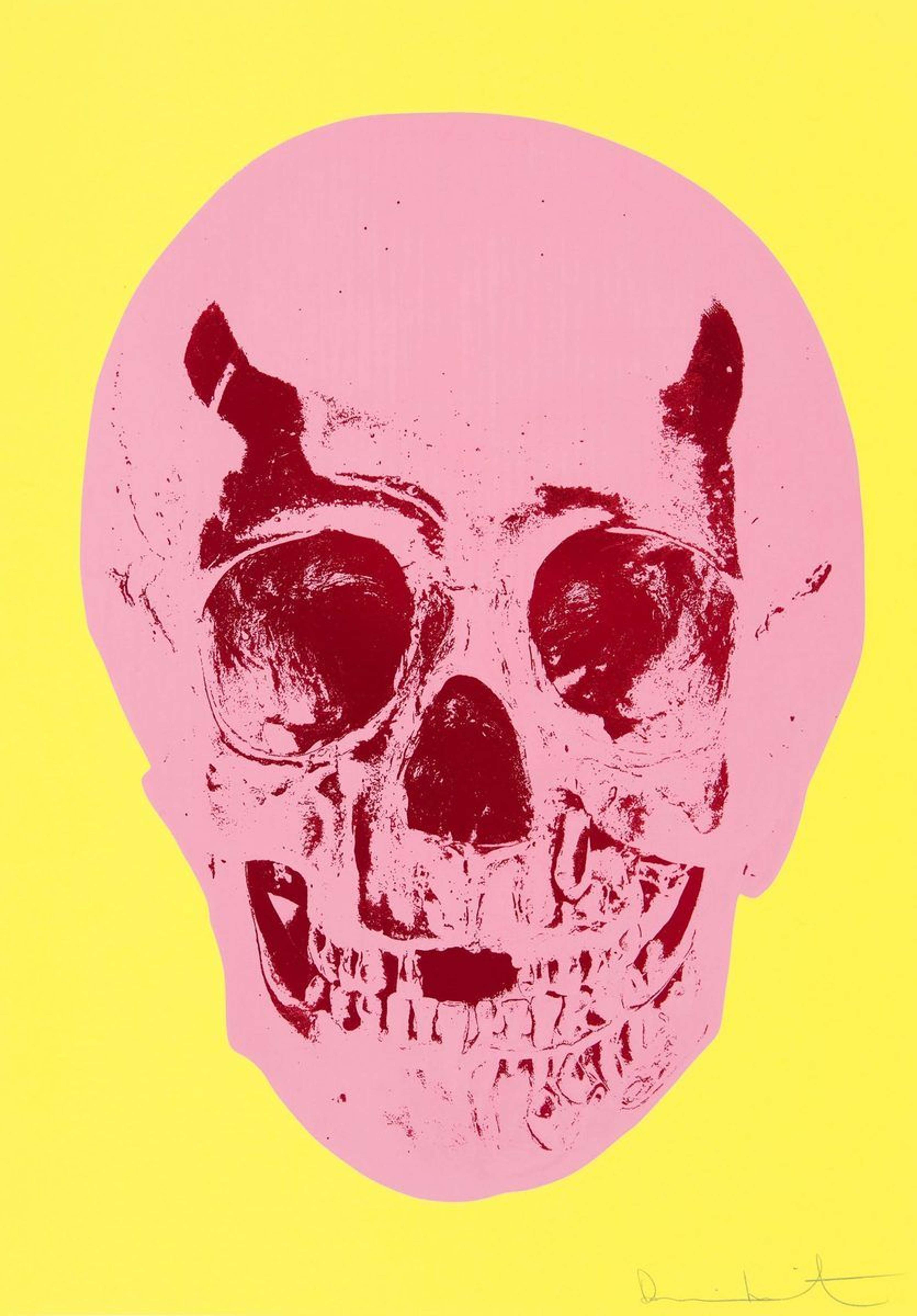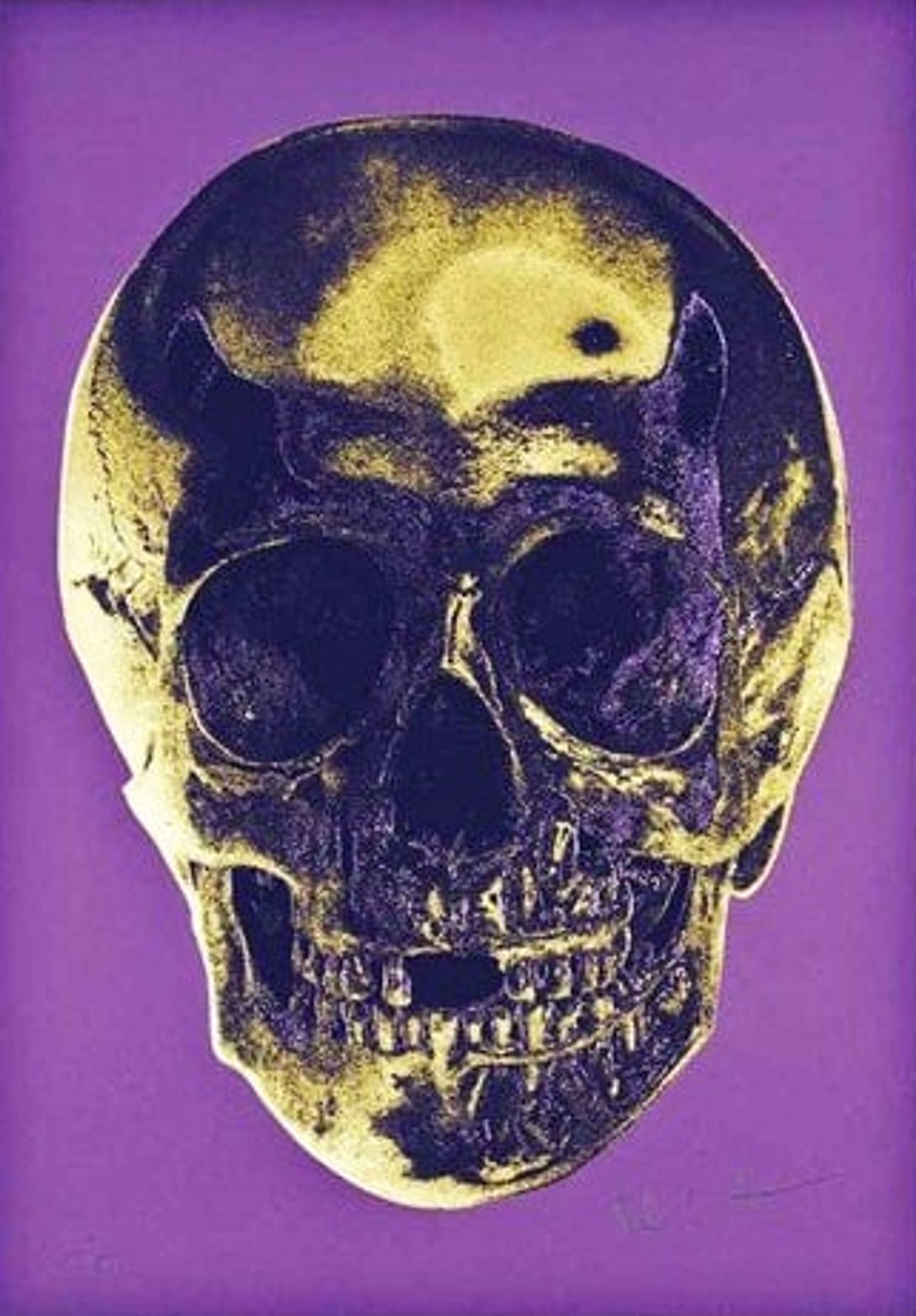10 Facts About Damien Hirst's Till Death Do Us Part

 Till Death Do Us Part (heaven lemon yellow pigment, pink, chilli red) © Damien Hirst 2012
Till Death Do Us Part (heaven lemon yellow pigment, pink, chilli red) © Damien Hirst 2012
Damien Hirst
677 works
Poster boy for the Young British Artists, Damien Hirst has always been fascinated with death and mortality. Till Death Do Us Part is a Warhol-inspired body of screen prints, forcing the viewer to confront the inevitable image and reality of death.
The skull is one of Hirst's most famed motifs.
 Till Death Do Us Part (purple african gold purple imperial purple) © Damien Hirst 2012
Till Death Do Us Part (purple african gold purple imperial purple) © Damien Hirst 2012Throughout his career, the skull has been one of Hirst's most evocative motifs. Speaking to his fascination with death and the macabre, the skull is a universal symbol for mortality, and one which Hirst has interpreted in an array of media. For The Love Of God, perhaps the most famous of Hirst's iterations of the skull, is an illustrious diamond-encrusted human skull and his ultimate expression of the memento mori.
Hirst is fascinated by death.
 Till Death Do Us Part (cerulean, blue pigment, yellow, royal red) © Damien Hirst 2012
Till Death Do Us Part (cerulean, blue pigment, yellow, royal red) © Damien Hirst 2012Across sculpture, painting, printing, and photography, death has always been the guiding subject in Hirst's oeuvre. This was a subject most controversially expressed in his formaldehyde works, but Till Death Do Us Part is a tongue-in-cheek allusion to the inevitability of death.
The skull is a traditional memento mori.
 Till Death Do Us Part (heavenly peppermint green, silver gloss, racing green) © Damien Hirst 2012
Till Death Do Us Part (heavenly peppermint green, silver gloss, racing green) © Damien Hirst 2012Much like the physical skull in For The Love Of God, the skull that forms the basis for Till Death Do Us Part is Hirst's ultimate memento mori. All prints in the series capture the skull head-on, as though its sockets were gazing out directly to the viewer. The prints are ghostly and uncanny, presenting the viewer with an eerie view into death. The series reminds us of our own mortality and the impermanence of all life.
The series depicts the same skull image in 10 different colour variations.
 Till Death Do Us Part (dove grey, gunmetal, leaf green) © Damien Hirst 2012
Till Death Do Us Part (dove grey, gunmetal, leaf green) © Damien Hirst 2012Across the series, Hirst imbues each of his eerie skulls with life through his bold application of unnatural colour. Each work seems to dress death in an alluring fashion, temporarily clouding the the stark reality of death.
The series is heavily inspired by Pop Art and Andy Warhol.
 Till Death Do Us Part (heaven lemon yellow pigment, pink, chilli red) © Damien Hirst 2012
Till Death Do Us Part (heaven lemon yellow pigment, pink, chilli red) © Damien Hirst 2012In his repetitive process of screen printing, Hirst mimics both the method and palette of Andy Warhol. The YBA appropriated the aesthetic of Pop Art to heighten the satirical tone of the entire portfolio. The skull appears much like Warhol's 'superstars' - with Marilyn Monroe, Mick Jagger and Mao among their ranks - to show what really lies beneath the veil of fame and excess.
The series creates an interplay between science and religion.
 Till Death Do Us Part (bright orange african gold emerald) © Damien Hirst 2012
Till Death Do Us Part (bright orange african gold emerald) © Damien Hirst 2012Throughout his artistic career, Hirst has displayed his fascination with science and religion through his focus on death. His particular interest in pharmaceuticals, as we see in his Utopia series, speaks to this interest in ways of combatting death with science. In Till Death Do Us Part, however, death is an inevitable reality that must be confronted and accepted by the viewer.
The series showcases Hirst's wry sense of humour.
 Till Death Do Us Part (candy floss pink, racing green, pigment red) © Damien Hirst 2012
Till Death Do Us Part (candy floss pink, racing green, pigment red) © Damien Hirst 2012The macabre title of the series alludes to the promise made between partners in their marital vows. With his focus on the head-on skull, Hirst avoids any romanticism, and reveals instead the bleak reality of the force that will inevitably drive couples apart - if divorce doesn't get them first.
The prints are made with foil block and glaze.
 Till Death Do Us Part (coral red, silver gloss, true blue) © Damien Hirst 2012
Till Death Do Us Part (coral red, silver gloss, true blue) © Damien Hirst 2012Though Hirst's subject for this series is bleak and gruesome, he has rendered each skull with luxe materials that make a mockery of death. Through his use of foil block and glaze during the printing process, the skulls assume a dazzling reflective quality. The surface of these prints makes them almost mirror-like, confronting the viewer with their inevitable fate.
The series toys with a typical prop of vanitas painting.
 Till Death Do Us Part (milk chocolate brown, true blue, bubblegum pink) © Damien Hirst 2012
Till Death Do Us Part (milk chocolate brown, true blue, bubblegum pink) © Damien Hirst 2012Popular from the 16th century onwards, vanitas painting littered the still-life with objects to remind their patrons and viewers of their mortality. Throughout art history, the skull has been one of the most repeated and central motifs of this genre. Given Hirst's near obsession with death and mortality, it is no surprise that the skull should form such a large proportion of his immense oeuvre.
The series creates an unsettling contrast between life and death.
 Till Death Do Us Part (viridian leaf, green, chocolate) © Damien Hirst 2012
Till Death Do Us Part (viridian leaf, green, chocolate) © Damien Hirst 2012In their almost mirror-like reflective quality, and their subversive bold colouring, these prints force the viewer to contemplate life and death. Hirst has always been keen to remind viewers of their own mortality, but Till Death Do Us Part makes death seem like an almost beautiful reality that unites us all.
